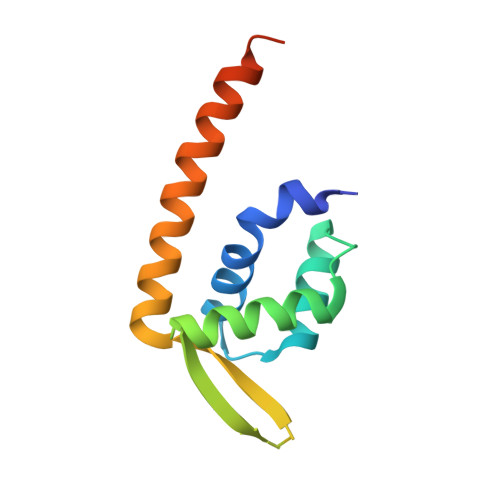Crystal Structures of Two Transcriptional Regulators from Bacillus cereus Define the Conserved Structural Features of a PadR Subfamily.
Fibriansah, G., Kovacs, A.T., Pool, T.J., Boonstra, M., Kuipers, O.P., Thunnissen, A.M.(2012) PLoS One 7: e48015-e48015
- PubMed: 23189126
- DOI: https://doi.org/10.1371/journal.pone.0048015
- Primary Citation of Related Structures:
4ESB, 4ESF - PubMed Abstract:
PadR-like transcriptional regulators form a structurally-related family of proteins that control the expression of genes associated with detoxification, virulence and multi-drug resistance in bacteria. Only a few members of this family have been studied by genetic, biochemical and biophysical methods, and their structure/function relationships are still largely undefined. Here, we report the crystal structures of two PadR-like proteins from Bacillus cereus, which we named bcPadR1 and bcPadR2 (products of gene loci BC4206 and BCE3449 in strains ATCC 14579 and ATCC 10987, respectively). BC4206, together with its neighboring gene BC4207, was previously shown to become significantly upregulated in presence of the bacteriocin AS-48. DNA mobility shift assays reveal that bcPadR1 binds to a 250 bp intergenic region containing the putative BC4206-BC4207 promoter sequence, while in-situ expression of bcPadR1 decreases bacteriocin tolerance, together suggesting a role for bcPadR1 as repressor of BC4206-BC4207 transcription. The function of bcPadR2 (48% identical in sequence to bcPadR1) is unknown, but the location of its gene just upstream from genes encoding a putative antibiotic ABC efflux pump, suggests a role in regulating antibiotic resistance. The bcPadR proteins are structurally similar to LmrR, a PadR-like transcription regulator in Lactococcus lactis that controls expression of a multidrug ABC transporter via a mechanism of multidrug binding and induction. Together these proteins define a subfamily of conserved, relatively small PadR proteins characterized by a single C-terminal helix for dimerization. Unlike LmrR, bcPadR1 and bcPadR2 lack a central pore for ligand binding, making it unclear whether the transcriptional regulatory roles of bcPadR1 and bcPadR2 involve direct ligand recognition and induction.
Organizational Affiliation:
Laboratory of Biophysical Chemistry, Groningen Biomolecular Sciences and Biotechnology Institute, University of Groningen, Groningen, The Netherlands.














